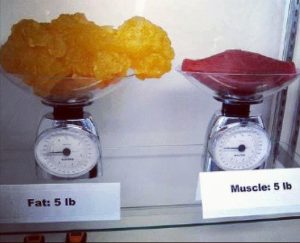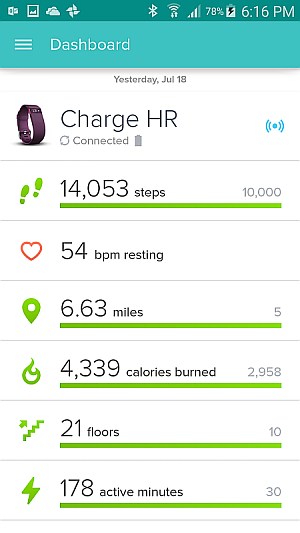I always love hearing the myths and fitness lies and thinking about where they came from. Here is a list of lies, or at least partial lies and why. Changing your mindset to reflect reality is one of the best things that you can do to make better eating and exercise decisions.
Sometimes the things that you think are true and that you rely on as a base for your diet, exercise, loss, or muscle gain plans are wrong and your are making false assumptions. Here are a few that you may be thinking are true that are in fact false
10 Fitness Lies And The Truth Instead
A lot of cardio is the most efficient way to lose body fat. FALSE!
 This is the most popular of fitness lies. Excessive cardio will strip muscle mass and body fat. This is definitely not the most efficient method for losing body fat. Once you begin stripping muscle mass, your body becomes less efficient at burning body fat. Muscle is metabolically active, which simply means it stimulates the metabolism.
This is the most popular of fitness lies. Excessive cardio will strip muscle mass and body fat. This is definitely not the most efficient method for losing body fat. Once you begin stripping muscle mass, your body becomes less efficient at burning body fat. Muscle is metabolically active, which simply means it stimulates the metabolism.
For each pound of muscle you put on, you will burn up to 50 additional calories per day. If you strip muscle mass, all you accomplish is sabotaging your efforts to efficiently reduce body fat.
You can gain 20 pounds of muscle in a few months. FALSE!
All the claims that you read about certain routines or supplements that can help you gain “10 pounds of muscle in a month” are big fat lies. They’re marketing scams to get you to buy a product. It takes diligent training using sufficient overload, consistency and patience to build significant muscle mass. Except for initial muscular gains which happen quickly when one begins a training program, it can take up to a year to gain 5-6 pounds of muscle mass.
Calories are the only thing that counts when trying to lose fat or gain muscle. FALSE!
Ratios of protein, carbohydrate and fats are also important. The key to losing fat and gaining muscle is controlling and manipulating insulin levels. In simple terms, when we consume excessive calories or excessive amounts of high glycemic carbohydrates at one meal, the body’s blood sugar rises. When this happens, the pancreas secretes insulin to lower blood sugar levels.
One of the many drawbacks of this happening excessively is, along with putting you at risk for diabetes, the body also holds onto stored fat! A balance of protein, carbohydrate and fats works most efficiently in losing fat and gaining muscle.
A woman will get muscles as big as a guy if she lifts heavier (8-12 reps). FALSE!
This fitness myth never seems to die. A woman has approximately one third of the testosterone of a man. Unless she is on anabolic steroids, growth hormones or other chemicals, a woman will never achieve the muscular size of a man. However, she can get a degree of muscularity that makes her lean, hard and tight.
You can put on a lot of muscle and lose a lot of fat at the same time. FALSE!
You can put on muscle and lose some fat in minimal amounts. However, the body functions best when it has one goal at a time. If your goal is to put on a lot of muscle, then make that your number one objective. If your goal is to lose significant body fat, then your focus should be on preserving your much earned muscle mass.
In 2001, prior to starting my training for one of my bodybuilding shows, I weighed 164 pounds (I compete as a bantam or light) at 15.7 percent body fat. In 2003, prior to starting to train for a show this June, my was 169.5 pounds at 12.6 percent body fat. As you can see, I put on some muscle and lost some fat. The change was significant but realistic. As I prepare for my show in June, I will attempt to preserve what I’ve earned as I reduce to approximately 3 percent body fat.
Lifting lighter weights will make your muscles more defined and cut. FALSE!

Muscle responds to overload. If you lift heavier with sufficient intensity, you will create more microscopic tears in the muscle. When the muscle recuperates, it will become bigger and stronger over time.
However, your supplemental nutrition must support your training. Reduced body fat is what creates the “cut” look, not high (15 or more) reps. Reduced body fat is a result of efficient training, proper amounts of cardiovascular exercise and nutrition that places you in somewhat of a calorie deficit. That’s how you get defined.
The best way to lose fat is to eat very few calories. FALSE!
Of all fitness lies this is the most dangerous because it can make you very sick. Always consider your body from the inside out. Your body’s main objective is to survive. It doesn’t care if you want to lose fat. In fact, it would prefer to increase fat in case of famine. Internally, the body has no idea that it’s the year 2003. It could still be 10,000 years ago for all it cares. Survival is its number one objective.
If you eat very little, the body perceives an emergency and will accommodate you by holding onto stored body fat. As well it should, because it has no idea when it will be fed again.
The best way to lose fat is to eat a lot of calories. FALSE!
Just as you don’t want to eat too little, you don’t want to eat too much. Duh. I know this is a ‘no brainer,’ but the big message in the nutrition and personal training world today is that most people need to eat more to stimulate the metabolism. The truth is you need the CORRECT AMOUNT of total calories to lose body fat, not simply more food!
One pound of muscle and one pound of fat are the same size. FALSE!
 If I place one pound of muscle on a scale and one pound of fat on a scale, they will both weigh one pound. The difference is in total volume. One pound of muscle may appear to be the size of baseball; one pound of fat will be three times the size and look like a squiggly bowl of JELL-O.
If I place one pound of muscle on a scale and one pound of fat on a scale, they will both weigh one pound. The difference is in total volume. One pound of muscle may appear to be the size of baseball; one pound of fat will be three times the size and look like a squiggly bowl of JELL-O.
The more protein I consume, the more muscle I will put on my body. FALSE!
The human body requires the correct amount of protein to put on muscle. The hardworking trainer requires a lot more protein than the sedentary person. However, the correct amount is key, not excessive amounts. In addition, the body uses protein, carbohydrate and a small amount of fat to build muscle, not simply excessive protein.
These are the most obvious fitness lies that I can think of and are backed up with lots of testing and the answers are really the truth. When we are trying to get in better shape and learn what is right and what is wrong there seems to always be conflicting information so we have to hold on to certain “Truths” and move on from there. I hope that these truths help you out and get you to a place where you are reaching all your fitness goals and not falling for fitness lies that will just slow you down.



